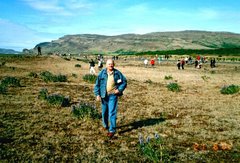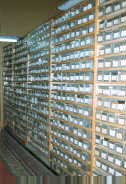
PRODUCTION of SEED
L.T. Kartuzova and B.S. Kurlovich
Many breeders use to start organizing the primary production of seed prior to sending new cultivars to the State Commission for Variety Testing. Thus, they achieve adequate adaptation of new cultivars, and produce sufficient quantities of seed materials indispensable for realization of large-scale state trials and production line testing. When the prospects of a cultivar have officially been recognized, implementation of primary seed production starts in the whole system of the zone where this cultivar is to be commercialized. The ultimate goal of primary seed production is to receive a yield of elite seeds. Such elite seeds obtained in research institutions and experimental facilities should possess high sowing qualities, best fruit-bearing properties, and no less that first-category purity. Seed production of lupin is conducted according to a definite scheme, which includes the following phases (Таранухо, 1980):
· nurseries for multiplication of the 1st and 2nd year progeny;
· site for superelite seed production;
· site for elite seed production.
In order to set up a nursery for assessment of the 1st year progeny, the seed of elite plants are used that were selected during the previous year in the progeny assessment nursery or on the best sites of the nursery for multiplication of the 1st year progeny. For selection of elite plants only clusters of the central plantlets should be taken, as their seed have the best physical, biochemical, sowing and fruit-bearing qualities.
Each selected cluster is threshed separately, its seed are checked up for typicalness and alkaloid content, and after that they are placed in an individual package. Seed of every individual descent are sown in spring separately from the others. Each individual seed progeny preserved in a separate package are sown not on a plot, but in one row - on three- or four-meter strips depending on seed quantity. Every row on such strips represents a descent of a single cluster. There is no need to separate each cluster by a label with such stowing method of arranging a nursery for assessment if the 1st year progeny. In this case, conditions for plant development are also more favorable. Sowing in such nursery is done in wide rows in order to increase of the multiplication factor in the best clusters. Spacing between rows is made with 45 cm intervals.
The main objective of the nurseries designed for assessing progenies is to discard the clusters that on any stage of their development have shown deviations from the cultivar standards in morphological, biological or commercial properties. During the whole vegetation process, comprehensive careful observations of plants are carries out. Removal of discarded clusters or individual plants is made in four stages (during the appearance of shoots, at the flower budding phase, during the flowering phase, and before rogueing at the phase of maturing).
In the nursery for assessment of the 2nd year progeny, sowing is performed in family clusters as in a collection nursery. The size of plots depends on the quantity of seed collected. Maintenance, observation and discarding in such nurseries are the same. Elite seed of the same cultivar serve as reference.
The nurseries for multiplication of the 1st and 2nd year progenies serve for accelerated preliminary multiplication, further improvement of a cultivar and obtaining high-grade seed of parent elite. In the first year of multiplication, seed from the 2nd year progeny assessment nursery are used for sowing after joining together the best descents. The obtained seed yield is harvested when the nursery is filled in the 2nd year of multiplication. In both seed nurseries sowing is performed in wide rows with 45-60 cm spacing between rows, or in belts with 45-60 cm spacing intervals between belts and 7.5-15 cm inside the belts, at the sowing rate of 70-80 kg/ha. Careful observations are conducted in the process of plant development, and rogueing is made, as required, with discarding underdeveloped, diseased or otherwise undesirable plants. During rogueing, plants are tested for alkaloids by using for this purpose alkaloid-sensitive paper. Seed collected from the 2nd year progeny multiplication nursery are sown on a completely isolated site with the purpose of obtaining super-elite seed. Super-elite seed have 100% varietal purity, are high yielding, and belong to the 1st class of the sowing standard. Obtained on these sites, seed are sown in the following year for producing elite yield.
Approbation of the yield of fodder lupin cultivars requires certain measures to estimate their qualities, assess the degree of injury caused by diseases, and check up the presence of alkaloids in plants and seeds. Approbation is carried out during flowering after rogueing of the plant harvest. In the beginning of approbation, one should check up observance of spatial isolation between different cultivars and species of fodder and bitter lupins. With the absence of natural barriers, spacing intervals between cultivars of yellow fodder lupin should be no less than 200 m. Field examination of each site is to be made separately in an area no more than 100 ha. For this purpose, 1000 plants should be analyzed on the greatest diagonal – 20 plants chosen at random in 50 localities at regular intervals. For the given variety of plants, the total number representative of morphological characters is calculated, and the number of plants afflicted by Fusarium wilt, bacteriosis and virus diseases is recorded. Every fourth plant from the tested sampling is checked up for alkaloids. The results of such field approbation are recorded in the certificate.
Test paper impregnated with Dragendorf’s reagent for determination of alkaloids is prepared as follows: 0.42 g acetic or bismuth nitrate is diluted in 25 ml of 20% acetic acid (solution А); 10g of potassium iodide is diluted in 25 mg of distilled water (solution B). Both solutions are drained, and 75 ml of 20% acetic acid is added. Filter paper is soaked in the preparation produced, and desiccated in darkness. Such paper can be preserved for a long time. For convenience, the test paper is cut into sheets, which are stitched into special notebooks. On each sheet, a grid of 100 squares is drawn with a simple pencil. When alkaloids are analyzed in plants in field conditions, one should break a young leaf with a leafstalk and place of its demolition to press to a piece of test paper. The presence of alkaloids will make on it a red-brown impression, on which it is easy to count up the percentage of alkaloid impurity.
Varietal purity and presence of alkaloid impurity can also be determined by the analysis of seed. In this case, one should apply Dragendorf’s reagent to solutions No. 1 and No. 2, which also can be made manually. At first, a concentrate of the reagent is to be prepared. In a measurement tube one should place 2 g of potassium iodide and dilute it in 3 ml of water, then add 1.3 g of crystalline iodide, carefully shake until the chips are completely dissolved, and add up to 100 ml of water. To make solution No. 1, it is necessary to add 19 ml of water to 1 ml of the concentrate. Solution No. 2 is ready if 9 ml of water is added to one ml of the concentrate. The solutions need to be stored in a dark place.
When analyzing each seed, it is necessary to cut off a small segment of seed shell, carve out a slice of cotyledons, and put it on a glass, which has been placed on a sheet of white paper. Then 1-2 drops of reagent No. 1 should be spilled from a dropper on each sample. The appearance of red-brown stains will point out to the content of alkaloids in an amount over 0.1 %. Such seed should be regarded as an alkaloid one. The seed that produced no stains must contain alkaloids less than 0.1%. They should be analyzed again in reagent No.2. The appearance of a stain in this case testifies that the seed contains less than 0.1% but more than 0.025% of alkaloids, and may be recognized as having low alkaloid content. All remaining seeds that have not shown color paints in reagent No. 2 contain less than 0.025% of alkaloids, and are considered as practically alkaloid-free. Later they may be used for crop production by farmers and in breeding practice.
For approbation, one can also use a simpler and more friendly method of preliminary boiling of seed. For this purpose, samples of 100 seeds in four repetitions are placed in gauze and boiled for 90 minutes, then chilled for 3-4 minutes, and put for 3 min in the prepared solution of iodide in potassium iodide. Then the samples are flushed in water, and brown coloring shows the quantity of alkaloid-containing seeds.
Seed of the first category have purity of no less than 99.5%, and the percentage of alkaloid seeds not exceeding 0.5%; the second category include seed with 98% and 2% respectively; the third with 95% and 3%. If seed yield does not conform to the third category even on one parameter, it is discarded.
Practical experience has shown that within three or four years it is possible to reach the required volume of elite seed production, and completely satisfy the need for seed of all farmers, collective farms and other seed producing enterprises.



1 comment:
Dear Sir/ Madam,
Good Morning.
Basis of Environment friendly crop-based Balanced NPK Fertilizer Rcommendation for Crops:
Integrated organic and inorganic fertilization is needed to
increase the yield of crops. Fertilizer policy
is initiated based on the longterm experimental findings,
practical experience and observations.Fertilizer
recommendation for any crop is made depending on soil,
plant analytical results, yield of crops.so, reach
desired goal checked-climate,plant population,pest and
disease control measures,the critical values of
specific crop soil in specific areas.More at
www.northernfertilizer.org
Thanking You
Kbd. Durlave Roy
R and D MANAGER and International Executive
NORTHERN AGRO SERVICES LTD,BANGLADESH.
Krishibid. consultation@yahoo.com
Post a Comment